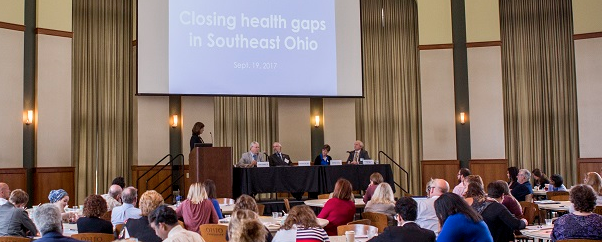Health Policy Institute of Ohio promotes health equity in southeast Ohio
Achieving a healthy population is no easy feat. According to the Health Policy Institute of Ohio, a partner of the Voinovich School, population health is determined not only by factors related to the health care system, but also by lifestyle choices, physical environment, and social and economic environments. Further complicating matters, large disparities exist in the quality and accessibility of resources based upon race, economic status, age, disability status and more. That’s why HPIO’s recent conference for regional health advocates and health care providers, hosted by Ohio University on Sept. 19, focused not on simply improving clinical health care, but on eliminating health disparities and achieving “health equity” in southeast Ohio.
HPIO President Amy Rohling McGee drew attention to the organization’s 2017 Health Value Dashboard, a report produced with assistance from Voinovich School faculty, which ranked Ohio 46th out of the 50 states and the District of Columbia in terms of health value – a composite measure of population health and state spending on health care.
“Improving health is something that we all care about, and that our elected officials care about,” McGee said. “We also know that spending is a concern for taxpayers, consumers, policymakers and businesses, so we need to pay attention to costs as well, in order to ensure that our efforts to improve health are sustainable. That’s why health value is the goal.”
Eliminating disparities is essential to achieving health value in the state, McGee explained.
“When gathering data for the dashboard, we calculated roughly how many Ohioans would have better health outcomes if disparities and inequities were eliminated for given metrics,” McGee said. “For example, we estimated that nearly 127,000 children in Ohio would not be exposed to second-hand smoke if the disparity between low-income and moderate- to high-income Ohioans were eliminated. If the racial and ethnic disparity for poverty rates were eliminated, more than 130,000 black children in Ohio would not be living in poverty. If the disparity for rates of depression among those with and without disabilities were eliminated, almost 441,000 Ohioans would not suffer from depression.”
Amy Bush Stevens, HPIO’s vice president of prevention and public health policy, shared evidence-based strategies to reduce those disparities and inequalities. For example, school-based health centers and tobacco cessation programs reduce disparities associated with health care access. Meanwhile, healthy food in convenience stores, incentives to purchase fruits and vegetables for users of SNAP benefits, and school breakfast programs reduce disparities associated with access to healthy food. Stevens also cited earned income tax credits, housing assistance programs and early childhood education programs as strategies to reduce economic inequalities that affect health.
Participants with various agencies in southeast Ohio also related their strategies for promoting health equity during a panel discussion.
Richard Wittberg, Director of the Washington County Health Department is establishing community gardens and promoting greater restrictions on tobacco use, including making community parks tobacco free. Ron Rees with the Corporation for Ohio Appalachian Development develops programs for early childhood care and education, senior care, and regional economic development. Mark Cardosi with Southeastern Ohio Legal Services provides free legal advice to low-income communities. Finally, Theressa Snyder, Voinovich School MPA alumnae and the Director of Perry Behavioral Health Choices, develops and promotes drug prevention and education programs.
“We wear many hats because we see many needs,” Snyder said.
The day concluded with a presentation on becoming involved in policymaking, which stressed the importance of persistence.
Amy Bush Stevens said she hopes the audience left the event feeling motivated to create change.
“I hope attendees took away that proven strategies already exist to reduce disparities and inequities,” Stevens said. “Some of these strategies are already being implemented, and the attendees at this event can help to make those strategies more widespread and coordinated.”
